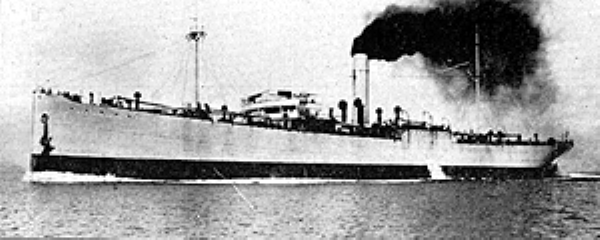| Tamahoko Maru |
Tamahoko Maru

| Operator | Kaiyo Kisen |
| Classification | |
| Gross tonnage | 6,780 tons |
| Speed | |
| Departure point | Takao, Taiwan |
| Departure date | 20 June 1944 |
| Destination | Japanese homeland |
| No. of POWs | 772 (US 43, Brit 190, Aus 267, Dutch 266) |
| Location of disaster | 10 NM SW of Nomozaki, Nagasaki-ken |
| Date of disaster | Midnight, 24 June 1944 |
| POW casualties | 560 |
| POW survivors | 212 (US 13, Brit 42, Aus 72, Dutch 85) |
| Photo | Source UNK. If the copyright holder is known, please advice. |
On 3 June 1944, a large convoy HO-02, consisting of 19 vessels including Tamahoiko Maru and Miyo Maru carrying more than 900 POWs aboard, left Singapore escorted by four coastal defense vessels and Minelayer Wakatake. They arrived at Manila on 11 June. The US intelligence had actively been keeping their ears open on the movement of this convoy by intercepting and decoding the Japanese communications regarding the convoy. Convoy spent the following three days in Manila, during which time Tamahoko Maru loaded 7,500 tons of copper ore. In Manila, the convoy was downsized to six vessels, and left there for Takao on 14 June. On their way over, they encountered a big typhoon, and no POWs could eat and use the benjo (lavatory) rigged outboard, until they barely made it into Takao.
Moreover, Miyo Maru was damaged by the typhoon, on 18 June, the POWs were transshipped to Tamahoko Maru, which had the most available space even after having loaded 7,500 tons of copper ore; they were given two holds with bearable living conditions.
HO-02 convoy sailed out of Takao accompanied by numerous escorts on 20 June. After stopping over at Keeling on 21 June, the convoy headed directly for the Japanese homeland. As they neared Kyushu, the guards were in a lighthearted mood saying, "Tomorrow we will be home." However, the US intelligence had tenaciously been tracking down their progress from Singapore. On 19 June, they received a message from Takao and decoded, "HO-02 convoy will soon change course to Moji. It consists of 11 ships, several of which are carrying US POWs." In spite of the fact that they knew the POWs were aboard those ships, the submarines were sent after the targets.
Upon receipt of the orders to attack the convoy, the three US submarines, Tang, Tinosa, and Shark II hurriedly proceeded to the designated waters. On 24 June, they rendezvoused at a point 120 NM southwest of Nagasaki for briefing, and it was decided that Tang would position closest to inshore, and two other submarines position at 30 NM intervals to the west and wait for the convoy. On the night of the same day, after contacting the convoy, Tang successfully sneaked through the escort circle into the convoy, and decided to attack the ships on the right-hand column from inshore. Then, the convoy commander had stopped zigzagging, and slowed down from 12 knots to 10 knots, feeling safe in the home waters. As Tang got closer to the targets, she found that the ship in the van was a large four-mast freighter with a high composite structure, and the next was an engine-aft tanker or freighter. Shortly before twelve midnight, Tang fired three torpedoes to the trailing ship, and fired a spread of three mores to the leading ship. Tang immediately put all four engines on maximum power, and got outside the escort circle. The first torpedo hit directly under the forward hold, and the second hit amidships of Tamahoko Maru. Water poured into the hold, and in a little more than one minute after the torpedo hit, the ship went down to the bottom with several hundreds people aboard.
At around 10:00 on the following morning, the rescue ships arrived at the scene of disaster. Soldiers were the first to be picked up, then women and children. The POWs were the last.
The explosion was violent; the ship sank rapidly, and in sufficient number of life preservers and life boats accounted for the loss of 560 POWs out of 772.
On the afternoon of 25 June, the 212 survivors of Tamahoko Maru arrived at Nagasaki harbor. As they landed on the wharf, they were hosed down. From there, they were taken to Fukuoka POW Camp No.14 Branch Camp in town where Dutch POWs had been detained. On the morning of 9 August 1945, they would experience the explosion of an A-bomb dropped over Nagasaki.
Note: Regarding the No. of POWs, casualties, and survivors, reference was made to Death on the Hellships by Gregory F. Michno in which, however, some discrepancies were found.